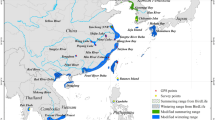Abstract
The Auckland Island shag (Phalacrocorax colensoi) is endemic to New Zealand and restricted to the subantarctic Auckland Islands. The species is classified as “Vulnerable” under the New Zealand threat classification systems. The total breeding population is estimated at <1000 pairs, with Enderby Island considered to be the stronghold for the species. The trend of the population is unknown, and it has been recommended a census of the entire adult population be conducted once a suitable methodology has been developed. The objective of this research was to examine census methods to estimate population size for the Auckland Island shag. Three census methods were trialled on Enderby Island during the 2011/2012 breeding season: (a) boat-based counts; (b) aerial photography using a helicopter and; (c) direct counts from the ground. The aerial photographic survey recorded 1889 pairs of Auckland Island shags breeding on Enderby Island during the 2011/2012 breeding season. In comparison, boat-based and ground count surveys recorded lower population sizes by 27 and 26 %, respectively. This research provides the first comparable methodology and baseline population estimate for the breeding stronghold of this threatened seabird and forms the basis for long-term population monitoring. All methodologies examined here could be used for other cliff-nesting seabird species; however, these results indicate a level of bias may be present for any survey method.


Similar content being viewed by others
References
Arata J, Robertson G, Valencia J, Lawton K (2003) The Evangelistas Islets, Chile: a new breeding site for black-browed albatrosses. Polar Biol 26:687–690
Baker GB, Jensz K, Cunningham R (2014) White-capped albatross aerial survey 2014 Final Report. Department of Conservation, Wellington. http://www.doc.govt.nz/Documents/conservation/marine-and-coastal/marine-conservation-services/meetings/pop2013-02-white-capped-albatross-population-estimate.pdf
Bell M (2007) Numbers and distribution of New Zealand king shag (Leucocarbo carunculatus) colonies in the Marlborough sounds, September–December 2006. Notornis 57:33–36
Bell M, Bell D (2000) Census of the three shag species in the Chatham Islands. Notornis 47:148–153
Bester A, Charteris M (2005) The second census of Chatham Island shag and Pitt Island shag—are numbers declining? Notornis 52:6–10
Buckland ST, Burt ML, Rexstad EA, Mellor M, Williams AE, Woodward R (2012) Aerial surveys of seabirds: the advent of digital methods. J Appl Ecol 49:960–967
IUCN (2012) IUCN Red list of threatened species. Version 2012.2. www.iucnredlist.org. Downloaded on 13 Jan 2015
Marchant S, Higgins PJ (1990) Handbook of Australian, New Zealand and Antarctic birds, 1: ratites to ducks. Oxford University Press, Melbourne
Millener PR (1972) The biology of the New Zealand pied cormorant Phalacrocorax varius varius Gmelin (1789). M.Sc. thesis, University of Auckland, Auckland, New Zealand
Moore PJ, McClelland PJ (1989) Notes on birds of the Auckland Islands, November–December 1989. Science and research internal report no. 93, Department of Conservation, Wellington
Nelson JB (2005) Pelicans, cormorants, and their relatives: the pelecaniformes. Oxford University Press, Oxford
Robertson CJR, Bell BD (1984) Seabird status and conservation in the New Zealand region. In: Croxall JP, Evans PGH, Schreiber RW (eds) Status and conservation of the world’s seabirds. International Council for Bird Preservation, Cambridge, pp 573–586
Robertson G, Moreno CA, Lawton K, Kirkwood D, Valencia J (2008) Comparison of census methods for Black-browed Albatrosses breeding at Ildefonso Archipelago, Chile. Polar Biol 31:153–162
Robertson H, Dowding J, Elliott G, Hitchmough R, Miskelly C, O’Donnell C, Powlesland R, Sagar P, Scofield P, Taylor G (2013) Conservation status of New Zealand birds, 2012. New Zealand Threat Classification Series 4. 22 p
Schuckard R (2006) Population status of the New Zealand king shag (Leucocarbo carunculatus). Notornis 53:297–307
Taylor GA (2000) Action plan for seabird conservation in New Zealand. Part A: threatened species. Department of Conservation, Wellington
Wolfaardt A, Phillips R (2013) Guideline census methodologies for albatrosses and petrels. Agreement on the Conservaiton of Albatrosses and Petrels. http://www.acap.aq/indes.php/en/resources/acap-conservation-guidelines
Acknowledgments
The work was conducted under permit from the New Zealand Department of Conservation (DOC). Data presented were collected with funding from the NZ DOC, part in parallel with field work undertaken for the DOC Marine Conservation Services Programme (http://www.doc.govt.nz/mcs) Project POP2007/01. We sincerely thank Chris Green and Southern Lakes Helicopters for helicopter charter and safe flying and Aurora Expeditions, especially Howard Whelan, for dedicating the use of a zodiac for the boat-based survey.
Author information
Authors and Affiliations
Corresponding author
Ethics declarations
Conflict of interest
All the authors declare that they have no conflicts of interest.
Ethical standard
All work is undertaken with the legal requirements of the country including care of animals in accordance with the New Zealand Department of Conservation Ethics Procedures and permits.
Rights and permissions
About this article
Cite this article
Chilvers, B.L., Baker, G.B., Hiscock, J.A. et al. Comparison of breeding population survey methods for the Auckland Island shag (Phalacrocorax colensoi). Polar Biol 38, 1847–1852 (2015). https://doi.org/10.1007/s00300-015-1745-5
Received:
Revised:
Accepted:
Published:
Issue Date:
DOI: https://doi.org/10.1007/s00300-015-1745-5




